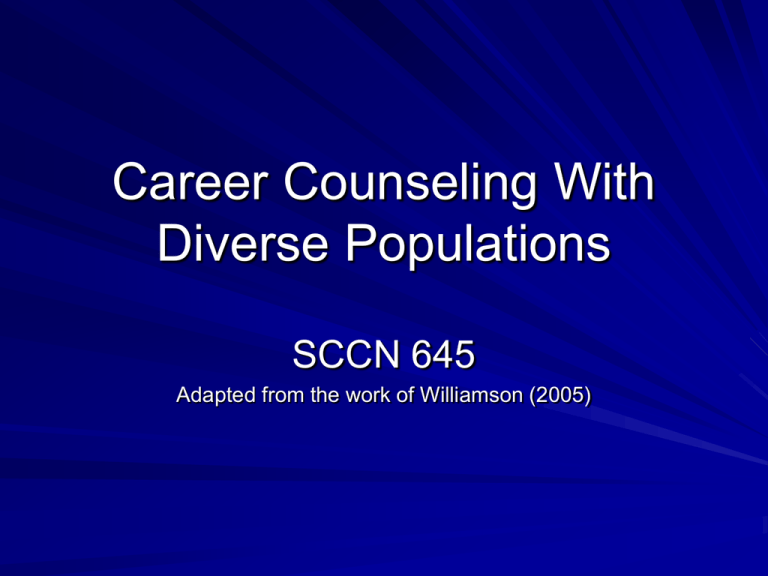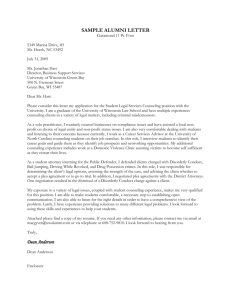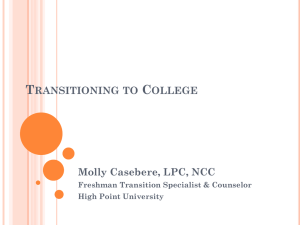
Career Counseling With
Diverse Populations
SCCN 645
Adapted from the work of Williamson (2005)
Multicultural Career Counseling
Culture can refer to many aspects of life
and living
Two people from the same race could
share some values, attitudes, and so on,
but might also be very different in their
cultural makeup.
Counselors should be alert to value
orientation when working with different
cultural groups
Multicultural Career Counseling
Cultural variability includes:
– Variability of worldviews including constructs
of individualism & collectivism
– Time orientation
– View of Human nature
– Personal space
– Privacy
Byars-Winston, A. M., Fouad, N. A. (2006). Metacognition and multicultural
competence: Expanding the culturally appropriate career counseling model.
The Career Development Quarterly, 54, 187-201.
Findings
– Fouad & Byars-Winston (2005) Metanalysis
No difference in career aspirations by self-reported
racial/ethnic groups
Racial/ethnic minorities perceived fewer career
opportunities and greater barriers
– Hold that counselors should evaluate their
culturally-relevant metacognitions when
working with clients
– Poses the CACCM with their own 7 steps
– Assert that “cultural differences in norms,
values, and expectations significantly shape the
emergence and recognition of a career problem
operate not only for the client but also for the
counselor.”
Multicultural Career Counseling
Culture does have an important role in workrelated values.
Differences between cultures helps us
understand employee attitudes, values,
behaviors, & interpersonal dynamics
Counselors must be aware of different cultural
orientations when establishing rapport.
Necessary skill areas include awareness of
differences, self-awareness, knowledge of
client’s culture, and adaptation of counseling
methods, materials, & procedures.
Multicultural Career Counseling
Optimal theory is multidimensional in
nature and emphasizes how
– Specific cultures influence and develop
worldviews
– The human universality of themes cut across
cultures
– The uniqueness of the individual is developed
Multicultural Career Counseling
Multicultural counseling and therapy theory
(MCT) was developed because many
contemporary theories of counseling do not deal
adequately with the complexity of culturally
diverse populations.
We must balance the focus of counseling,
expand the repertoire of helping responses,
identify indigenous helping roles, and develop
alternatives to the conventional counseling role.
Multicultural Career Counseling
Immigrants have special needs that
involve premigration process as well as
the adjustment process in a new &
different culture.
Adjustment to a new culture includes
transitions of reconstructing social
networks, adjusting to a new
socioeconomic system, and learning a
different cultural system.
Multicultural Career Counseling
Counselors must develop a great sensitivity to culturally
diverse clients when conducting an interview.
Technique issues include:
–
–
–
–
–
–
–
–
–
Eye contact
Touch
Probing questions
Space & distance
Verbal style
Restrictive emotions
Confrontation
self-disclosure
Focus on self-in relation & self-in-context
Career Development of African
American (AA) Clients
Swinton (1992) concluded that AA are
disadvantaged economically and
occupationally
– 36.9% of AA men, but 61.8% of White men
were employed in “good” jobs in 1990 (i.e.,
executives, administrators, etc.)
– 45.2% of AA men, and 23.9% of White men
were employed in “bad” jobs (i.e., laborers,
service workers, material movers, etc.)
Career Development of African
American Clients
Trait-Factor Theories
– Possibly do not consider unique needs,
intertwined with psychological testing of
minorities and ability testing (Anastasi, 1982;
Franklin, 1991, et. al.)
Super’s Theory
– Question of whether career maturity applies
across SES and ethnic background (Smith,
1983)
Career Development of African
American Clients
Holland’s Theory
– Miller, Springer, and Wells (1988) found that
most of their AA respondents recorded Social
type as highest or second highest personality
type
– Gottfredson (1978) reported that realistic and
social jobs surfaced as the most frequent
source of jobs for AA
– Gottfredson also found AA are poorly
represented in Enterprising work at all levels
Career Development of
Hispanic Clients
Predicted to soon be the majority, minority
group
Include heritages of Mexico, Cuba, Puerto
Rico, Central America, or Spain
Largest groups: Mexican, Puerto Rican,
Cuban
Concentrated more in lower-paid, lesserskilled occupations of the work force
Progress is being made with subsequent
generations
Career Development of
Hispanic Clients
Arbona (1990) suggested that middleclass and college-educated Mexican
Americans and Anglos are similar in their
attitude towards work
– Many variations in generational immigration
and attained level of education
Luzzo (1992) found that Hispanic college
students did not differ from their whiteAmerican peers in career decision-making
skills, attitudes, or vocational congruence
Career Development of Asian
Americans
Since 1980’s this population grew by 70%
Into the 2000’s continue to grow by 4050%
First generation student = “Superstudent”
Diverse Group heritages include
Japanese, Chinese, Vietnamese,
Cambodian, Filipino, Thai, Korean
Career Development of Asian
Americans
80% of all Asian Americans are in college
2 yrs. after high school – education is
viewed as vehicle to mobility
Family structure important – education is
tied to values of home
Typical male occupations (investigative
types) – engineers, computer scientists,
and mathematicians
Females are sex-typed like whites, but
generally lean towards investigative types
Career Development of Asian
Americans
Might prematurely constrict choices based on
prestige. May ignore variables such as interest
and aptitude.
Directive counseling preferable, authoritative
style – counselor who is confident and provides
structure, interpretation, and solutions to
problems
May place emphasis on extrinsic values: money,
stability, and security
Involve parents in intervention – linear social
values
Career Development of Native
Americans
No other group has experienced deeper
prejudiced or is in a less-advantaged
posture (Herr, Cramer, & Niles, 2005)
Nearly 50% of all NA live on NA lands and
some 275 reservations
Concentrated Los Angeles, San
Francisco, & Chicago
Over 450 recognized tribes (Casas &
Arbona, 1992)
Career Development of Native
Americans
Values significantly different from
mainstream: sharing, cooperation, the
group, a circular time orientation, harmony
with nature, and respect for elders
(Herring, 1996)
Extremely high unemployment rate
Enter a restricted number of occupations
(1/3rd of the relatively few who attend
college, earned their degrees in education
or social sciences)
Career Development of Native
Americans
Self-efficacy has been measured as lower
than that of Whites and Hispanics (Lauver
& Jones, 1991)
NA tend to prefer a counselor with similar
ethnicity
Parents seem to have a greater impact on
their children than other, particularly,
majority groups (Lee, 1984)
Gender Issues in Career
Counseling
Women are reassessing their career
priorities and looking beyond the
traditional feminine working roles.
Even though women are being given great
opportunities to expand their career
choice, barriers to the changing role of
women in the working world still exist.
Gender Issues in Career
Counseling
In response to the women’s movement,
men are reexamining their roles, beliefs, &
relationships with women.
The Society for the Psychological Study of
Men and Masculinity, Division 51 of the
American Psychological Association was
formed to study gender roles &
masculinity.
Gender Issues in Career
Counseling
Several Career Theorists have addressed
women’s issues
Super was one of the major career development
theorists who addressed career development
patterns of women.
He classified them into 7 categories: stable,
homemaking,conventional,stable working,
double track, interrupted, unstable, and multiple
trial.
Super among others viewed career development
of women as different from men.
Gender Issues in Career
Counseling
Ginzberg denoted three lifestyle
dimensions:
– Traditional (homemaker-oriented)
– Transitional (more emphasis on home than on
job.)
– Innovative (giving equal emphasis to job &
home)
Gender Issues in Career
Counseling
Zytowski (1960s) labeled vocational
developmental patterns of women as:
– Mild vocational
– Moderate vocational
– Unusual vocational
(Stages similar to Ginzberg)
Through vocational participation, woman can change
their modal lifestyle. Patterns of vocational
participation for women are determined by age at
entry, the length of time that a woman works, and the
type of work undertaken. Further determinants
include: individual motivation, ability, environmental
circumstances (such as financial need)
Gender Issues in Career
Counseling
In the late 1970s, Sanguiliano (1978)
emphasized the theme of different and
special needs of women.
He suggests that a woman’s life cycle
does not follow a rigid progression of
developmental tasks and that attention
should focus on unique paths that women
take to break away from gender role
stereotyping.
Gender Issues in Career
Counseling
Counselors must be aware of unique influences
that shape gender role development. Cultural
groups have some special needs that must be
addressed and individual differences within
groups must be recognized.
Each individual is influenced by a number of
specific cultural and situational factors that
contribute to gender stereotyping. Tentative
gender boundaries are established in childhood.
Gender role is intensified in adolescence. It is
not certain how and to what extent gender
differences remain stable among adults.
Gender Issues in Career
Counseling
Some special needs of men & women are:
– Gender stereotyping beliefs
– Fear of feminity and restrictive emotionally
restrictive emotionally among ment
– Sexual harassment in the workplace
– Problems for both men & women associated
with achievement
– Competition and self-destructive bahaviors
Gender Issues in Career
Counseling
Counseling approaches should be free of
gender role typing. Counseling strategy
components include working climate,
expressiveness training, dual career, &
lifestyle skills.
Issues Facing Dual-Career
Families
The family influence on career
development has been a significantly
relevant issue.
The family is conceptualized as a social
system.
The nuclear family is the most common in
the US. The extended family is the most
common around the world.
Issues Facing Dual-Career
Families
Current trends in family systems include:
–
–
–
–
–
–
–
–
–
–
increased number of single adults,
postponement of marriage,
decreased childbearing,
more female participation in the labor force,
more divorce,
more single-parent families,
more children living in poverty,
more remarriage,
increased years without children,
and more multigeneration families
Issues Facing Dual-Career
Families
There is a typical issue within dual career
families involving struggles for gender
equity of household and child care tasks
and of work recognition.
Issues Facing Dual-Career
Families
Issues facing dual career couples are:
– Expectations of work and family
– Role Conflict
– Child Care
– Geographic Moves
– Competition
– Relationship factors
– Numbers of personal factors
Issues Facing Dual-Career
Families
Implications of career counseling include:
– Illuminating underlying issues of gender
equity
– Couple communication
– Sharing exercises
– Family and career status
– Conflict resolution
Career Counseling for Gay,
Lesbian, & Bisexual Clients
G/L/B persons have special needs
because of their sexual orientation that
should be addressed in career counseling.
There are estimates of between 5 and 25
million g/l/b persons in this country.
More organizations are supporting gay
and lesbian associations and networks.
Many regard gay men and lesbian women
as another diverse group in the workplace.
Career Counseling for Gay,
Lesbian, & Bisexual Clients
Individuals with a sexual orientation of
g/l/b continue to be stereotyped as to the
kinds of jobs they should hold;
are threatened by violence often resulting
from homophobia,
form a dislike for themselves through
internalized homophobia;
and generally receive negative feedback
from a society that views heterosexuality
as the only viable lifestyle.
Sexual Minorities: Assessing
Identity
Cass (1979) model of sexual identity development
Stage 1. Identity Confusion- not knowing or
understanding much about his or her own sexual
minority orientation
Stage 2. Identity Comparison- the individual
acknowledges the possibility of being attracted to the
same sex
Stage 3. Identity Tolerance- the individual tolerates
rather than accepts and identification of an individual
whose sexual orientation is different
Sexual Minorities: Assessing
Identity
Stage 4. Identity Acceptance- this stage is characterized
by continued contacts with other l/g/b persons to validate
a new identity and a new way of life
Stage 5. Identity Pride- the individual takes pride in
disclosing an identity as l/g/b
Stage 6. Identity Synthesis- when one accepts his or her
sexuality
Career Counseling for Gay,
Lesbian, & Bisexual Clients
Discrimination in the workplace can involve:
–
–
–
–
–
–
–
–
Threats
Lack of Promotion
Black mail
Ostracism
Sexual harassment
Exclusion or avoidance
Termination
The Lavender Ceiling
Mixture of Blue and Pink, “two-spirited” or “twin-spirited”
Career Counseling for Gay,
Lesbian, & Bisexual Clients
Unique issues g/l/b persons bring to counseling
can be resolved in career counseling with some
adaptations and modifications.
Six stages that can be included within career
counseling models are:
–
–
–
–
–
–
Precounseling preparation
Establishing an affirmative trusting relationship
Client identification issues
Identify variables that can limit career choice
Tailored assessment
Job search strategies
Two Major Models of
Multicultural Career
Counseling
Values-Based Multicultural
Career Counseling (VBMCC)
Values-Based, Multicultural Approach
Work of Duane Brown
Based on a culmination of research on values
and multiculturalism from psychology and a
variety of other literature bases
Assumes that values can be defined within a
culture and must be addressed as truths in
career counseling
Unique in the approaches integration of
advocacy in the career counseling process
Values-Based, Multicultural Approach
This approach addresses 8 core areas:
1. The assessment of cultural variables
1. Assess early and sensitively
2. For example, “I am aware that in many Asian
American families, the family selects the occupation
for the children. Before we begin, I would
appreciate it if you would help me understand who
will make the decision in this case.”
2. A culturally appropriate relationship
1. Sensitivity to broader ethnic group
2. SOLER nonverbal communication model
8 Core areas continued
3.
The facilitation of the decision-making
process
–
4.
Who makes the decision?
The identification of career issues
(assessment)
–
–
Is crisis career counseling needed?
3 suggested, qualitative assessment devices
Pattern Identification
Achievement Profiling
Lifeline
8 Core areas continued
The establishment of culturally appropriate
goals
5.
–
–
Are client, family, and culture’s goals the same?
“Did your_____ affect this goal you set?”
The selection of culturally appropriate
interventions
6.
–
Possibly a mediation process when working with
individuals who have a collateral social value
orientation.
8 Core areas continued
7. The implementation and evaluation of the
interventions used
Interventions aligned with goals
Evaluation based on level of goal attainment
8. Advocacy
Requires working as a mediator between clients
and industry
Being aware of relevant information and
resources
Culturally Appropriate Career
Counseling Model
7 General Steps
Step 1: Establishing a Culturally
Appropriate Relationship
– Set the context for a working relationship
– Empathy, warmth, and positive regard
Step 2: Identification of Career Issues
– Help explore environment issues, role of
race/ethnicity, external barriers – sexism or
racism in the work environment
7 General Steps (Cont’d)
Step 3: Assessing the Impact of Cultural
Variables on Career Issues
– Explore how behavior has been a product of
client’s culture
– Consider behaviors client wants to continue or
change
– Help client understand spheres of influence
(e.g., gender, family, racial group, etc.)and
how they are operating
7 General Steps (Cont’d)
Step 4: Setting Culturally Appropriate
Processes and Goals
– Client-centered, co-created
Step 5: Implementing Culturally
Appropriate Interventions
– Consider other information data in the case
(e.g., assessment measures)
– Advocacy within a school setting, Pushing
client past foreclosure, etc.
7 General Steps (Cont’d)
Step 6 and 7: Decision-Making and
Implementation
– Help client make a decision relative to goals
and formulate a plan to implement
– For example, client may choose to confront
family values, sex-type roles, assertiveness
skills in confrontations, etc.







